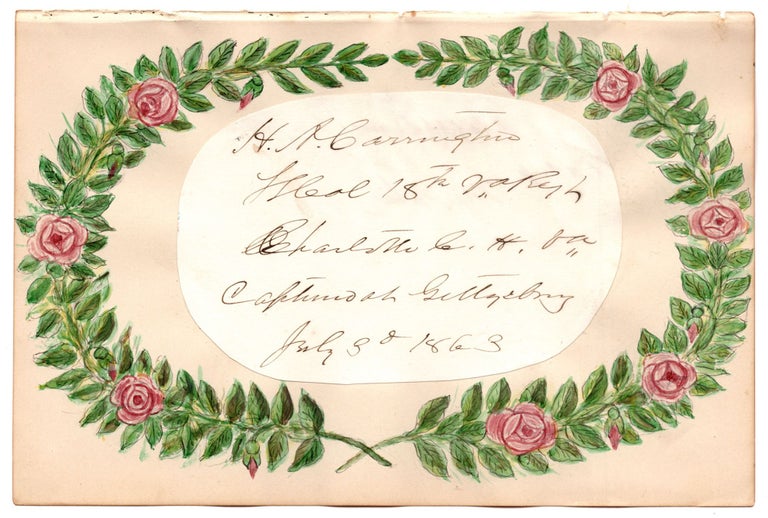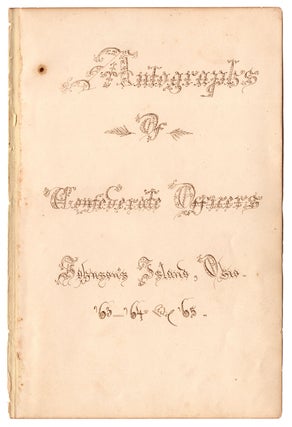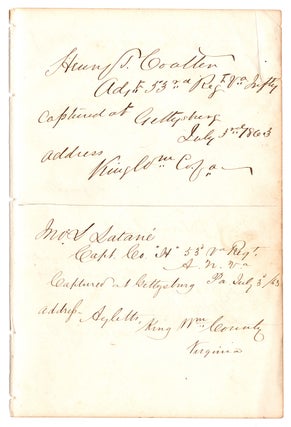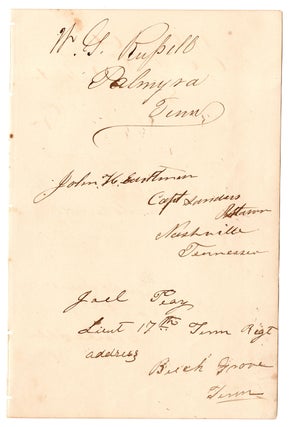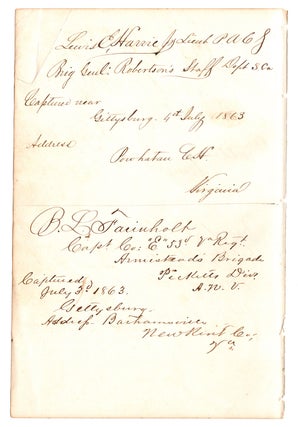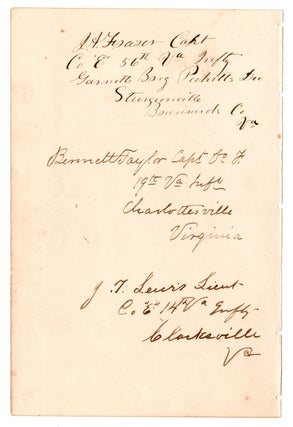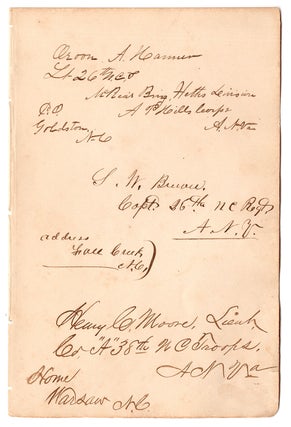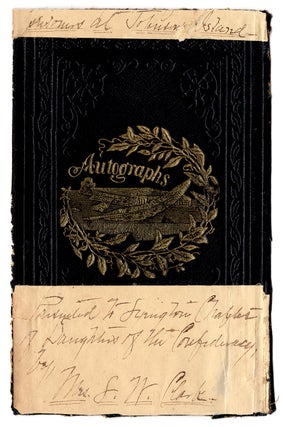Autographs of Confederate Officers, Johnson’s Island, Ohio. ‘63-’64 and ‘65.
Johnson’s Island, Ohio, 1863–1865. Manuscript title page with seventeen autograph inscriptions on six leaves (7.75” x 5”), one with ornamental ink and watercolor border; detached front cover of autograph book (8” x 5”) with mounted inscriptions on two pieces of paper: “Prisoners at Johnson’s Island” and “Presented to Lymington[?] Chapter of Daughters of the Confederacy by Mrs. L. W. Clark.” CONDITION: Good, one small spot of soiling to manuscript title page; moderate wear to front cover; light wear to the six leaves, one leaf with a crease at upper corner and a .5” tear with no affect to contents. A fascinating group of seventeen autographic inscriptions by Confederate officers, mostly Virginia natives, captured during or just after the Battle of Gettysburg and imprisoned at Johnson’s Island, Ohio, including the autographs of Captain Benjamin L. Farinholt, who successfully escaped, as well as the tailor who helped disguise him. The inscriptions include a range of details relating to the lives and military careers of these seventeen officers: their rank and position in the Confederate Army; home address; and when and where they were captured. Those who fought in the Battle of Gettysburg—at least thirteen men—often name the division and brigade they belonged to during the battle. Captain Benjamin Lyons Farinholt’s inscription reads as follows: “B. L. Farinholt, Capt. Co. ‘E’ 53d VA Regt. Armistad’s Brigade, Pickett’s Div. A.N.V. Captured July 3rd 1863, Gettysburg. Address Barhamsville, New Kent Co., Virginia.” Having arrived at Johnson’s Island on July 18th, 1863, Farinholt escaped the prison on February 22 of the following year by donning an improved Yankee uniform made by his tailor friend John L. Latane. On the day of his escape, Farinholt went with a group of his fellow prisoners to fetch fresh water from the island’s bay by cutting a hole in the ice. After a pre-arranged argument broke out among the prisoners, Farinholt slipped through the lines, handed Latane his gray shawl—underneath which he wore a blue shirt resembling a Union uniform—and joined a group of off-duty Union guards who were playing on the ice. The guards did not notice the addition to their ranks, and when they were ordered back, Farinholt began walking towards the city of Sandusky. There, he removed his “Union” uniform to wear only the civilian clothes he had layered beneath it. On March 8th, he arrived in Baltimore and continued south. By June, he was again leading Confederate forces in Virginia. Most of the other officers in this autograph book were, like Farinholt, from Virginia, but a few came from Tennessee, North Carolina, and South Carolina. Very popular in the 19th century, autograph books were one way that prisoners of war both passed and recorded their time while incarcerated. Lieutenant Colonel Henry A. Carrington’s autograph features a decorative ink and watercolor border of flowering rose branches. The Johnson’s Island prison, which operated between April 1862 and September 1865, combined its secure island location with proximity to various important Ohio cities and transportation lines. It held up to 3,000 prisoners at a time, and an estimated total of 10,000 over the course of the war. Conditions at Johnon’s Island were better than at most other Confederate and Union military prisons. Still, approximately 300 died during their imprisonment. THE SEVENTEEN OFFICERS 1. Captain Stephen W. Brewer (b. 1835) was mustered into the 26th North Carolina Infantry in June, 1861. Brewer was taken prisoner at Petersburg, Virginia and was imprisoned at Johnson’s Island and then at Point Lookout, MD, before being released in June, 1865. 2. Lieutenant Colonel Henry A. Carrington (d. 1885) was commissioned into the Field & Staff of the 18th Virginia Infantry in May, 1861. He was wounded in June, 1862 at the Battle of Seven Pines in Virginia, and again the following year at the Battle of Gettysburg, where he led the 18th Virginia in Pickett’s Charge under Gen. Richard B. Garnett. After being exchanged for a Union prisoner on 3 March 1864, he again led rebel forces, serving until the end of the war. 3. Lieut. Henry T. Coalter (b. 1834) was mustered into the Virginia Albemarle Light Artillery in August, 1861 and was commissioned into the Field & Staff of the Virginia 53rd Infantry in December, 1862. Captured at the Battle of Gettysburg, Coalter was imprisoned at a number of prisons including Johnson’s Island. He was paroled in December, 1864 in South Carolina. 4. Capt. John H. Earthman enlisted in May, 1861 in the 2nd Tennessee Infantry, Co. G. 5. Capt. Benjamin L. Farinholt enlisted in July, 1861 at West Point, Virginia in the 53rd Virginia Regiment, Co. E. Wounded in June, 1862 at the Battle of Oak Grove in Virginia, he was wounded again and captured at the Battle of Gettysburg on July 3rd, 1863. 6. Capt. Joseph A. Fraser (1832–1906) was mustered into the 56th Virginia Regiment, Co. E. Part of Garnett’s Brigade, Pickett’s Division during the Battle of Gettysburg, he was captured at the Stone Wall in Pickett’s Charge on July 3rd, 1863. Fraser arrived at Johnson’s Island on July 18th, 1863, and was exchanged in February, 1865. 7. 3rd Lieut. Orren Alston Hanner (b. 1843) was mustered into the 26th North Carolina Infantry, Co. E. First wounded in 1862 at Malvern Hill, Virginia, he was again wounded—this time severely—at the Battle of Gettysburg. He was taken prisoner on July 5th, 1863 while the Confederate Army was retreating, arrived at Johnson's Island in September, 1863, and was paroled in March, 1865. 8. Lieut. Lewis E. Harvie Jr. (ca. 1809–?) enlisted as a private in the 4th Virginia Cavalry in May, 1862 and served on Brig. Gen. Beverly Robertson’s staff. He was captured on July 4th, 1863 near Gettysburg, Pennsylvania. 9. 2nd Lieut. Thomas B. Jackson (1843–1925) was mustered into the 3rd Virginia Infantry in March, 1862. Jackson served in Kemper’s Brigade at the Battle of Gettysburg, during which he was wounded and taken prisoner. He arrived at Johnson’s Island in September, 1863 and was exchanged at Point Lookout, MD in March, 1865. 10. Capt. John L. Latane was mustered into the 53rd Virginia Infantry, Co. H in May, 1861 and was captured at the Battle of Gettysburg on July 3rd, 1863. In February, 1864, Latane aided Capt. B. L. Farinholt’s escape from Johnson’s Island with his skills as a tailor. 11. Lieut. John T. Lewis (b. 1841) worked as a farmer before enlisting in the 14th Virginia Infantry, Co. E. Wounded at the Battle of Gettysburg, he was captured in Pickett’s Charge on July 3rd, 1863. In addition to being imprisoned at Johnson’s Island, Lewis was also imprisoned at Fort McHenry, MD and Fort Delaware, DE. He was released in June, 1865. 12. 3rd Lieut. Henry C. Moore (b. 1836) worked as a farmer before being mustered into the 38th North Carolina Infantry, Co. A. Captured on July 3rd, 1863 at the Battle of Gettysburg, he arrived at Johnson’s Island on July 20th, 1863 before being exchanged in March, 1865. 13. 2nd Lieut. Joel Peay enlisted in the Tennessee 17th Infantry, Co. G in June, 1861. Peay was taken as a prisoner of war in June, 1863. 14. 2nd Lieut. William H. Rupert enlisted in March, 1862 in the Tennessee Washington Light Artillery, Co. C. 15. Capt. Bennett Taylor (ca. 1837–1898) was a teacher before being mustered into the 19th Virginia Infantry, Co. I in May, 1861. He was wounded twice before being wounded again and captured in Pickett’s Charge at the Battle of Gettysburg on July 3rd, 1863. Taylor arrived at Johnson’s Island on 18 July 1863 and was paroled in September, 1863. He was exchanged in March, 1865 at Point Lookout, MD. 16. Lieut. John S. Taylor was mustered into the 14th Virginia Infantry, Co. D in April, 1861. At the Battle of Gettysburg, he served in Armistead’s Brigade and after being wounded was captured in Pickett’s Charge on July 3rd, 1863. Taylor arrived at Johnson’s Island in October, 1863. In April, 1865, he was transferred to Fort Delaware, DE and was released in June, 1865. 17. Lieut. John Vermillion was mustered into the 9th Virginia Infantry, Co. K in April, 1862. Serving in Armistead’s Brigade at the Battle of Gettysburg, he was taken as a prisoner during Pickett’s Charge on July 3rd, 1863. He arrived at Johnson’s Island on July 5th, 1863 and was released from Fort Delaware, DE in June, 1865. A compelling group of autographic artifacts relating to the Confederate experience at Gettysburg and Johnson’s Island Prison, Ohio. REFERENCES: “Johnson’s Island” at Ohio History Central online.
Item #7506
Sold


